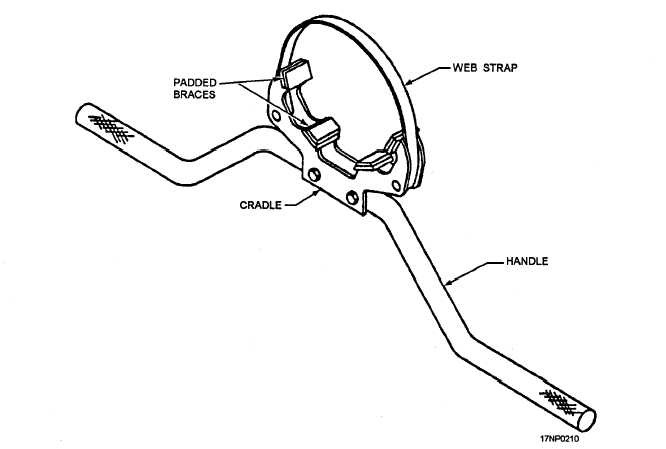secured with four bolts. There are also three tray
assemblies with rollers on top. When placed on the
main stand assembly, the trays ride on the permanent
rollers, allowing them to be pushed along the length of
the stand. The top-mounted rollers actually contact the
skin of the weapon and support its weight, permitting a
360-degree rotation of any weapon and allowing access
to screws and other parts.
The A/F32K-10 is primarily designed for use on
amphibious assault ships (LPH/LHA/LHD). It is used
in a predesignated magazine or bomb assembly area in
conjunction with an overhead rail and hoist system for
assembling bombs of various weights and sizes.
HOISTING BARS
LEARNING OBJECTIVE: Recognize the
purpose and use of hoisting bars.
Hoisting bars are used for carrying, lifting, and
handling weapons.
They are normally used during
weapons handling and loading evolutions.
AERO 64A1 HOISTING BAR
The Aero 64A1 hoisting bar (fig. 9-12) consists of
a cradle, strap, and two carrying handles. The cradle is
a weldment frame that has four padded braces. The
handles have knurled gripping surfaces. A missile is
secured in the cradle by a web strap attached to the
tie-down assembly and the bar buckle.
Two Aero 64A1 hoisting bars must be used to
manually lift a Sparrow or Shrike missile from a missile
skid to an aircraft wing or fuselage-mounted launcher.
AERO 68A HOISTING BAR
The Aero 68A hoisting bar (fig. 9-13) is a bar within
a bar that has a hook assembly attached. The length of
the bar can be increased by extending the internal bars
15 7/8 inches each.
To manually lift the weapon you must hook the
Aero 68A hoisting bar into the weapon lugs. This bar is
used to handle or transport any weapon having standard
lugs. Weapons weighing up to 1,000 pounds can be
lifted if two bars are used
Figure 9-12.—Aero 64A1 hoisting bar.
9-8

